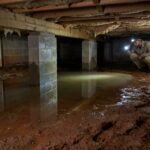Comprehensive Guide to Foundation Repair: Ensuring Your Home’s Stability and Longevity
When it comes to home ownership, ensuring the stability and longevity of your property is paramount. After all, everything you love—your family, your priceless collection of garden gnomes, and your Netflix stash—rests atop that all-important slab of concrete or those sturdy wooden supports. One crucial aspect often overlooked until it’s too late is the foundation. This guide will delve into the world of foundation repair and how you can keep your home standing strong against the trials of time—and maybe a few minor earth tremors.
Understanding the Foundation
Your home’s foundation is more than just a platform; it’s the backbone of your entire structure. It bears the weight of the house, distributes it evenly, and prevents soil erosion and water damage. Foundations can come in various forms, such as slab, crawl space, and basement types, each with its own merits and challenges.
**Slab Foundations** are typically made of concrete poured directly on the ground, providing a solid base. They are popular in warmer climates due to their simplicity and cost-effectiveness. However, they are also susceptible to cracking due to moisture changes in the soil.
**Crawl Space Foundations** offer a gap between the ground and the home, allowing for ventilation and easier access to plumbing and electrical systems. They can be an excellent choice for areas with heavy rainfall, although they require maintenance to prevent pest infestations.
**Basement Foundations** provide ample extra space and can be used for storage, living areas, or even as a gym (because who doesn’t want a workout space that doubles as a cold storage room?). Unfortunately, basements can also attract water and require careful management to maintain stability.
Causes of Foundation Problems
Before you can effectively repair your foundation, it’s essential to understand what could harm it in the first place. Many factors can lead to foundation issues, including:
1. **Soil Movement**: The soil under your home can shift due to moisture changes, freeze-thaw cycles, or erosion. Expansive clay soils, in particular, can be quite troublesome, expanding when wet and contracting when dry.
2. **Water Damage**: Poor drainage, leaking roofs, or unsealed foundation walls can lead to water pooling around your foundation, leading to cracks and weakening the structure. It’s like giving your house a permanent foot bath—but not in a good way.
3. **Tree Roots**: While trees can enhance your landscaping, their roots can wreak havoc on your foundation. They may absorb moisture from the soil, leading to shrinking and settling.
4. **Poor Construction**: Sometimes, the problem lies in how the foundation was built. If it was constructed with subpar materials or techniques, it might not withstand the test of time (or the weight of your improvised indoor trampoline).
Signs of Foundation Problems
So, how does one know when their foundation needs attention? Thankfully, our homes often send us signals, albeit subtle ones, that something might not be quite right. Keep an eye out for these warning signs:
– **Cracks in Walls and Ceilings**: Small, hairline cracks can be normal, but large or widening cracks, especially those that run diagonally or form in doorways and windows, may indicate foundation movement.
– **Uneven Floors**: If your once-flat floors suddenly resemble a rollercoaster ride, it’s time to evaluate your foundation. Sinking spots can create tripping hazards—unless, of course, you’re trying to live your best Mario Kart life.
– **Doors and Windows Not Closing Properly**: If you find yourself wrestling with your doors and windows, they may be out of alignment due to foundation shifts. An unwillingness to open or close is a telltale sign that your home might be settling in ways it shouldn’t.
– **Gaps Between Walls and Trim**: Look for gaps where your walls meet the trim. If you notice any shifting or gaps, it could suggest that your foundation is under stress.
– **Erosion Around the Foundation**: If soil is washing away from the foundation, it’s a sign that water drainage isn’t functioning correctly. Telling your home to “stay put” is not enough if gravity and water are at odds.
Foundation Repair Methods
Once you’ve established that your foundation may need some TLC, you can explore various repair methods. Here are common techniques, each with its advantages and considerations:
1. **Piering**: This method involves the use of piers to stabilize and lift the foundation back to its original position. Steel or concrete piers are driven deep into the ground beneath the troubled area, effectively redistributing the load and preventing further shifting. Think of it as giving your house a supportive hug from below.
2. **Slabjacking**: If you have a slab foundation that’s settled or cracked, slabjacking might be the remedy. This technique entails injecting polyurethane foam or a cementitious material beneath the slab to fill voids and lift it back to level. It’s like giving your floor a gentle boost.
3. **Wall Anchors**: For bowing or leaning walls, wall anchors can be installed to correct these structural issues. Metal rods are anchored into stable soil outside your home and connected to your basement walls, pulling them back into alignment. A little reinforcement can go a long way.
4. **Drainage Solutions**: Often, water problems lead to foundation issues. Adding or improving drainage systems such as gutters, downspouts, and grading away from the foundation can help mitigate excess moisture. It’s akin to placing your house on a float in a waterpark—no unwanted splashes allowed!
5. **Crawl Space Encapsulation**: If you have a crawl space, sealing it off from moisture with vapor barriers can help keep humidity at bay and prevent your foundation from deteriorating over time. It’s the home equivalent of putting on a raincoat before heading into a storm.
Choosing the Right Foundation Repair Company
While DIY projects can be fun and rewarding, foundation repair is best left to the professionals—unless you enjoy playing a real-life game of Jenga with your house. Here are some tips for finding the right foundation repair company:
– **Research**: Check online reviews, ask for recommendations from friends or neighbors, and look for companies with a good track record.
– **Experience**: Ensure the company has experience specifically with foundation repairs. A plumber may be great at fixing leaks, but that doesn’t make them a foundation expert.
– **Free Estimates**: Most reputable companies will provide free estimates. That way, you can compare costs and methods without committing to anything upfront.
– **Warranty**: Ask about warranties on the repairs. A reliable company should stand behind their work, giving you peace of mind that your foundation will remain intact.
– **Licensing and Insurance**: Verify that the company is licensed and insured. This protects both you and the workers should anything go awry during the repair process.
Preventative Measures
The best repair is often prevention. Here are some tips to keep your foundation healthy and reduce the likelihood of future problems:
– **Maintain Proper Drainage**: Ensure gutters and downspouts direct water away from your foundation. Consider installing a French drain if excessive water accumulation is an issue.
– **Water Your Lawn Wisely**: During dry spells, be mindful of watering your lawn. Over-saturating the ground near your foundation can lead to soil expansion, while neglecting it can cause contraction. Aim for balance.
– **Monitor Tree Growth**: Regularly assess the proximity and health of trees near your home. Trees with aggressive root systems may need a trim—or a new home if they start causing issues.
– **Inspect Regularly**: Make it a habit to inspect your foundation and the interior of your home for early signs of trouble. Catching issues early on can save you time, money, and countless headaches later.
Conclusion
Foundation repair may seem daunting, but understanding the basics can empower you to take action and ensure the stability and longevity of your beloved home. By recognizing the signs of foundation issues, choosing the right repair methods, and taking preventative measures, you’ll be well-equipped to secure your dwelling for years to come.
Remember, a strong foundation is not just about keeping your house upright; it’s the cornerstone of a happy home where memories are made—like epic dance-offs in the living room or baking cookies that mysteriously disappear before anyone can take a bite. So, take care of your foundation, and it will take care of you!


